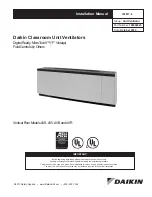
EN-8
451905.66.07 · FD 9912
www.gdts.one
English
DHW 300VD+
4.2 Installation
Remove the three transport restraint screws (M12 - fixing
the device to the pallet) from the bottom of the pallet.
Remove the pallet and mount the three M12 supporting
feet (in the plastic bag attached to the cylinder pipe nipple).
Position the domestic hot water heat pump and align it ver-
tically by adjusting the device feet. Then tighten the coun-
ter nuts on the device feet.
ATTENTION!
!!
The ventilation unit and the corresponding disconnecting
device for the power supply must be freely accessible at all
times.
NOTE
º
The air circuit of all air inlets and outlets, as well as overflow
passages, must not be obstructed, covered or sealed. Settings
carried out by the technician must not be changed.
It must be possible to shut off combustion air lines and exhaust
gas systems of fireplaces that depend on room air to ensure
fault-free operation of the ventilation unit.
ATTENTION!
!!
Special requirements apply for simultaneous use of
ventilation systems and fireplaces. Country-specific and
regional rules and regulations must be observed. Early
consultation with the relevant chimney sweep is strongly
recommended!
4.3 Air distribution system
The air distribution system is connected on the device. An ex-
tract air duct connects the ventilation unit with the external wall
vent or roof hood. An exhaust air duct connects the ventilation
unit with the air distribution system and with the valve or venti-
lation grille.
NOTE
º
The air duct system must be sized and planned according to
the requirements of the building and the selected ventilation
unit (see chapter System design).
An incorrectly sized or incorrectly installed air duct system
can result in inadequate ventilation or increased odour
problems, draughts and excessive energy consumption.
Country-specific and regional rules and regulations must be
taken into consideration and observed.
NOTE
º
Extractor hoods and vented tumble driers must not be
connected to the domestic ventilation unit! It is advisable to
use extractor hoods with air circulation and condensing
tumble dryers.
4.3.1 Thermal insulation air distribution
system
The ventilation unit and air distributor must be installed within
the thermally insulated building shell.
NOTE
º
To prevent condensate formation, extract air ducts must be
sealed completely air-tight at both sides and over the entire
route between the ventilation unit and air inlet/outlet with a
sufficiently strong steam-resistant thermal insulation! When
using a ventilation hose with multiple layers, the outer shell in
particular must be masked off so it is air-tight! The
temperatures in the duct are approximately the same as the
outside temperature level.
Exhaust air ducts must also be fitted with thermal insulation to
prevent heat losses if they pass through unheated areas or
areas with limited heating.
4.3.2 Sound insulation
Install sound-damping ventilation hoses or sound dampers in
the exhaust air duct and in the extract air duct. Flexible air hoses
must be installed in an accessible location for cleaning or re-
placement.
To prevent vibration transmission from the ventilation unit to
the duct system, connect all air ducts flexibly to the ventilation
unit.
When installing mountings, clips, brackets and other duct
mountings, sound-damping measures should be used where
applicable. Wall or ceiling openings must be filled and sealed
with suitable material. If ventilation ducts are installed in the in-
sulation layer under the screed, suitable vibration decoupling
and impact sound decoupling measures must be used (e.g. in-
sulation strips under the ventilation pipe).
The sound transmission from adjoining rooms (transmitted
sound) is suppressed with a star-shaped set-up of the air duct
system.
4.3.3 Air inlets and air outlets
The extract air are routed through external wall grilles or roof
cover, the positioning of which must factor in sunlight, the di-
rection of the weather and prevailing wind, snow levels and
other external influences.
Arrange air outlets and inlets in the room such that a good flow
of air through the room is ensured. Position ventilation valves
on the ceiling or in the top part of walls and take into account
the subsequent position of the furniture (particularly seats and
beds, in order to prevent perceived draughts).
Hallways are overflow areas through which air flows from sup-
ply air rooms to exhaust air rooms. Air overflow vents must be
provided to ensure unobstructed overflow. These can be imple-
mented by means of gaps beneath doors or ventilation grilles.
















































